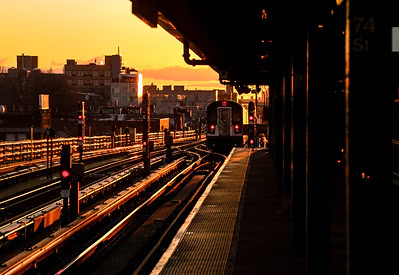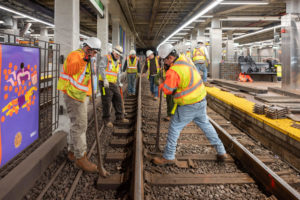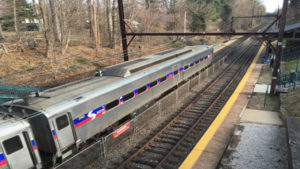MBTA Focuses on Safety; Releases Independent Track Maintenance Audit and Publishes Internal Safety Review
Written by Jennifer McLawhorn, Managing Editor
BOSTON – Yesterday, the MBTA released its track maintenance audit and published an internal safety review.
Yesterday, the MBTA released its track maintenance audit and published an internal safety review. The independent report was conducted by Carlson Transport Consulting LCC, and the second report was an internal review by MBTA’s Safety Department. According to the release, both “revealed deficiencies in track inspection processes, including inconsistencies in documentation and oversight”, and both recommended improvements in “leadership, standardizing procedures, increasing staffing and training, and clearly outlining roles and responsibilities.” Since this past Spring, the MBTA says it has taken measures to address track issues and hired experienced engineers and established standard operating procedures.
Phillip Eng, MBTA General Manager and CEO, stated that the two reports echo his own observations. One of which “was the need for improved coordination and communication between departments responsible for critical maintenance work and, at the same time, clear lines of responsibilities and accountability. Additionally, while there is a tremendous amount of institutional knowledge within the team, it was evident that we needed reinforcement. We have added seasoned public transportation veterans, bringing fresh perspectives and best practices from other major transit agencies. As we continue to build out the leadership team, we remain focused on ensuring the safety of our workforce and riders while we restore our infrastructure and improve service for the public we serve.”
Back in March of this year, the Department of Public Utilities conducted an inspection of the Red Line and discovered the track repair documentation was lacking. Because of these findings, the MBTA commissioned the independent investigation into the track inspection failures, and the inspection found “inconsistent defect identification, lack of defect verification, inadequate oversight of inspections, and inappropriate track geometry criteria.” The MBTA Safety Department also agreed with these findings.
According to the release, the independent report makes recommendations in process & procedures, staffing, and roles & responsibilities, as laid out below:
- Process & Procedures
- The MBTA will work to develop and issue standard operating procedures for inspections (both visual and third-party). These procedures should include documentation requirements. Additionally, the MBTA should “involve appropriate personnel in witnessing the third-party track inspections, consider alternative track geometry criteria that more closely fit the MBTA system, and develop a long-range track improvement plan.”
- Staffing
- The Massachusetts Bay Transportation Authority will hire more staff in its MoW division and “evaluate compensation and responsibility parity across departments.”
- Roles & Responsibilities
- MoW positions at the MBTA should be elevated, and the MBTA should “modify the selection process and qualification requirements for roles with inspection responsibilities, and enhance training, certification, and recertification for roles with inspection responsibilities.”
The issues identified in the independent report match up with the issues in the FTA’s Safety management Inspection. MBTA’s Quality, Compliance & Oversight Office is working to address these issues. Their efforts include “staffing assessments, hiring plans, documentation of procedures, and quality management.” The Office is working to focus on the following areas:
- Enhancing selection/qualifications – in order to have only the most qualified individuals for track inspections.
- Increasing Maintenance of Way staffing – to be sure that track inspection needs are met and “to improve the efficiency of the inspection process.”
- Improving Training – to ensure inspectors are up to date with the latest techniques/technologies and “help them develop the skills they need to identify and report defects in a timely and accurate manner.”
- Ensuring Section Foremen can witness vendor testing: to ensure these tests are done properly and “that defects are not missed.”
With the MBTA already working to follow its “strategic values, goals, and metrics to improve safety, service, equity, sustainability, and culture,” Eng commented that the MBTA owes it “to the people of Massachusetts and everyone who visits our state to take a critical look at our approach and make tough decisions in a timely manner that best serve the needs of the organization.” The press release from the MBTA reports that this work is already being done.
Additionally, the agency has taken steps involving documentation and training, staffing, inspections, and preventative maintenance in order to address inspection and maintenance.
Documentation and Training
- After the March Geometry records finding, the MBTA conducted an inspection of documentation and records to help identify any additional gaps.
- In June of this year, the MBTA issued a Standard Operating Procedure (SOP) for track geometry testing “to standardize documentation and defect resolution.” The draft SOPs for other inspections are under final review.
- It improved the training program for positions related to systems repairs by updating the program curricula this past June. These updates included “adding an additional week to the existing 2-week program, increasing the training by 50%, consisting of supplementary fieldwork, specific digital reporting tool training, and an 8-week OJT program.” The revised program curricula will start by December.
- The MBTA hired three track instructors and will hire three more to have a total of six track instructors in the future. Moreover, the MOW Department will increase its training space by acquiring two more classroom trailers.
Staffing
- Since December of last year, MBTA has hired 30 track laborers and is working to hire another 50 track positions in the near future.
- The MBTA hired a Senior Director of Maintenance of Way and Chief of Infrastructure last month. Both have extensive experience in track inspection, maintenance, and construction. Additionally, the MBTA plans to recruit Director and Deputy Director positions “to fill track department leadership positions.”
- In FTA’s Safety Management Inspection (SMI) program for determining “optimal staffing levels for section, maintenance, and capital intiatives,” there are currently workforce assessments underway.
Inspections
- It issued “a directive to address critical ‘black condition’ defects immediately.” These defects are logged using a color-coded guide that ranges from green to yellow to red to black, with green being the best and black being the worst. If a defect is ‘green’, it is considered minor and does not need immediate attention. A defect marked ‘yellow’ is moderate and needs to be repaired soon. If a defect is ‘red’, it needs to be fixed quickly as it is considered severe. And, if a defect is ‘black’, its condition is critical and “requires immediate attention.” For yellow and red conditions that need repairs, speed restrictions are used as a mitigation measure.
- It updated the geometry testing SOP “to set expectations for MOW staff requiring real-time reporting of critical defects to Section Foreperson for immediate verification and resolution.”
- It issued an RFI, or Request for Information, last month to help “gather industry feedback on geometry testing requirements and criteria.”
- The MBTA implemented a program for inspections that utilize “external experts to provide real-time mentoring for internal inspection staff.”
Preventative Maintenance
- Preventative maintenance scheduling and planning was improved to “optimize the efficiency of regular repairs and upkeep.”
- In order to expand coverage and access, it acquired more inspection vehicles and equipment.
The issues that the FTA’s Safety Management Inspection found match up with those found in the independent report. In response, the MBTA reports that it has “already been actively working to fix these problems through its Quality, Compliance & Oversight Office” and “has made strides this summer on the FTA response, closing another CAP on August 18, 2023, under another Special Directive.” This brings the total “closed CAPS to 3 of 39 and 6 of the 42 findings under the SMI Report.”
Over the past few months, the MBTA has focused its efforts on track maintenance and MOW management practices, managing the impact of operations, maintenance, and capital project requirements on the existing workforce, and operating conditions and policies, procedures, and training.
For Track Maintenance and MOW Management Practices, the MBTA corrected track defects and is working to develop “the processes, tools, reporting equipment, resources, and budget to fix maintenance backlogs and establish proactive maintenance management practices.”
In Managing the Impact of Operations, Maintenance, and Capital Project Requirements on the Existing Workforce, the MBTA is currently documenting its requirements “across the organization with a specific focus on understanding the interdependencies between operations, maintenance, and capital projects.” Additionally, it will develop a five-year hiring plan that addresses the workforce assessment outcomes.
In terms of Operating Conditions and Policies, Procedures, and Training, the MBTA reports that it will “develop an understanding of training gaps for its workforce, develop and implement that training, and develop a centralized training governance program to ensure appropriate quality, tracking, and administration of training across the authority.”
With all these efforts from the MBTA to address safety, Eng maintained the organization’s commitment to making it “the safest and most reliable transit system in the country. . . Systemic process and infrastructural failures do not happen overnight; as a result, we need a strong commitment to addressing longstanding issues. That’s why we are reviewing the entire organization and clarifying responsibilities and accountability across the leadership team. The status quo is unacceptable, and we are rebuilding the workforce as we rebuild our infrastructure. It is our responsibility to put our workforce in positions to succeed with clear direction, appropriate training, and resources.”
Moreover, the MBTA hired “two track veterans to enhance its track oversight,” Chief of Infrastructure Doug Connett and Senior Director of Maintenance of Way Jody Ray. Connett has almost four decades of experience with operations, safety, and maintenance in public transit, and he joined the MBTA last month to help “provide direction to the entire Infrastructure Directorate, which is comprised of over 1,000 employees within the track, signals and communications, power, facilities, and logistics teams.” He will also execute programs that improve the quality of service, work to reduce costs, and increase employee productivity, revenue, and ridership.
Jody Ray is a veteran of Commuter Rail with track maintenance and construction experience. He is “transitioning to the Maintenance of Way Division.” Both Connett and Ray will be “responsible for the overall track management and condition.”
Earlier this Spring, in April, the Governor “appointed a new MassDOT Chief Safety Officer with significant track experience.” Pat Lavin supports the MBTA in its efforts and commitment to safety. MBTA reports that Lavin has four decades of experience “in transportation safety and operations, including as a subject matter expert and technical writer for the MBTA Safety Review Panel in 2019.” Before that, he served as “Executive Vice President and Chief Safety Officer for the Washington Metropolitan Area Transit Authority (WMATA) and Senior Director for Operations in the Office of System Safety of New York City Transit.”
Eng signed off on the press release, stating that the MBTA has “supplemented our existing team with seasoned veterans of public transportation systems who have over 100 years of experience combined. . . I know that addressing these areas of concern will take time and collective effort, but I’m confident that together, we can achieve our goals and make a difference here at the T. We’re going to keep at this until the MBTA is the best it can be for our riders.”





